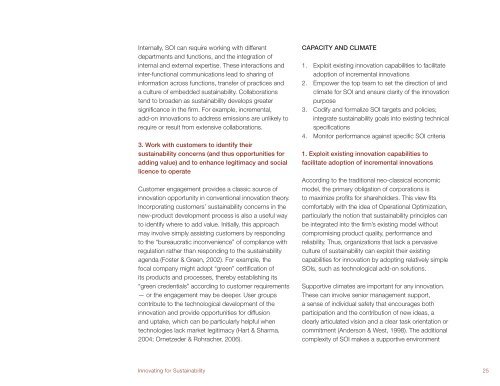Systematic Review - Network for Business Sustainability
Systematic Review - Network for Business Sustainability
Systematic Review - Network for Business Sustainability
You also want an ePaper? Increase the reach of your titles
YUMPU automatically turns print PDFs into web optimized ePapers that Google loves.
Internally, SOI can require working with different<br />
departments and functions, and the integration of<br />
internal and external expertise. These interactions and<br />
inter-functional communications lead to sharing of<br />
in<strong>for</strong>mation across functions, transfer of practices and<br />
a culture of embedded sustainability. Collaborations<br />
tend to broaden as sustainability develops greater<br />
significance in the firm. For example, incremental,<br />
add-on innovations to address emissions are unlikely to<br />
require or result from extensive collaborations.<br />
3. Work with customers to identify their<br />
sustainability concerns (and thus opportunities <strong>for</strong><br />
adding value) and to enhance legitimacy and social<br />
licence to operate<br />
Customer engagement provides a classic source of<br />
innovation opportunity in conventional innovation theory.<br />
Incorporating customers’ sustainability concerns in the<br />
new-product development process is also a useful way<br />
to identify where to add value. Initially, this approach<br />
may involve simply assisting customers by responding<br />
to the “bureaucratic inconvenience” of compliance with<br />
regulation rather than responding to the sustainability<br />
agenda (Foster & Green, 2002). For example, the<br />
focal company might adopt “green” certification of<br />
its products and processes, thereby establishing its<br />
“green credentials” according to customer requirements<br />
— or the engagement may be deeper. User groups<br />
contribute to the technological development of the<br />
innovation and provide opportunities <strong>for</strong> diffusion<br />
and uptake, which can be particularly helpful when<br />
technologies lack market legitimacy (Hart & Sharma,<br />
2004; Ornetzeder & Rohracher, 2006).<br />
CAPACITY AND CLIMATE<br />
1. Exploit existing innovation capabilities to facilitate<br />
adoption of incremental innovations<br />
2. Empower the top team to set the direction of and<br />
climate <strong>for</strong> SOI and ensure clarity of the innovation<br />
purpose<br />
3. Codify and <strong>for</strong>malize SOI targets and policies;<br />
integrate sustainability goals into existing technical<br />
specifications<br />
4. Monitor per<strong>for</strong>mance against specific SOI criteria<br />
1. Exploit existing innovation capabilities to<br />
facilitate adoption of incremental innovations<br />
According to the traditional neo-classical economic<br />
model, the primary obligation of corporations is<br />
to maximize profits <strong>for</strong> shareholders. This view fits<br />
com<strong>for</strong>tably with the idea of Operational Optimization,<br />
particularly the notion that sustainability principles can<br />
be integrated into the firm’s existing model without<br />
compromising product quality, per<strong>for</strong>mance and<br />
reliability. Thus, organizations that lack a pervasive<br />
culture of sustainability can exploit their existing<br />
capabilities <strong>for</strong> innovation by adopting relatively simple<br />
SOIs, such as technological add-on solutions.<br />
Supportive climates are important <strong>for</strong> any innovation.<br />
These can involve senior management support,<br />
a sense of individual safety that encourages both<br />
participation and the contribution of new ideas, a<br />
clearly articulated vision and a clear task orientation or<br />
commitment (Anderson & West, 1998). The additional<br />
complexity of SOI makes a supportive environment<br />
Innovating <strong>for</strong> <strong>Sustainability</strong> 25
















